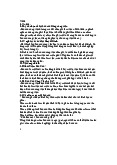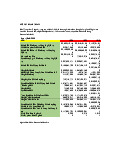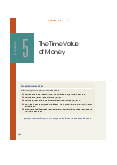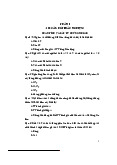




Preview text:
REFERENCE ANSWER EXERCISE LECTURE.9 Chapter 13 1.
The effective rate that a company pays on its current debt; it can be measured as either before-tax
or after-tax returns; however, because interest expense is deductible, the after-tax cost is seen
most often. This is one part of the company's capital structure, which also includes the cost of equity.
In our task we have the following given data. Time = 20 years, Coupon rate = 9%, Sales cost of
debt = $1 050, Tax bracket = 35%, Dividend = $4, Stock price = $40, Cost of equity = 12.5%,
Equity = 59%, Preferred stock = 20%, Debt = 30%. 2.
Firstly we need to find the Interest rate on debt. We apply the calculation in Excel and obtained
the value which is equal to 8.46%.
Now we need to determine the after tax cost of debt accordingly to the given condition of the
task. We apply the following formula.
After − tax cost of debt = Rd (1 − tc)
Rd represents the cost to issue new debt, not the cost of the firm's existing debt.
After − tax cost of debt = 8.46% ∙ (1 − 35%) = 5.499% Now our task is to calculate the Cost of
Preferred Stock. Cost of preferred stock (Rps) can be calculated as follows: Rps = Dps / Pnet
Where: Dps is preferred dividends, Pnet is net issuing price. We can substitute the given
data into the noted above formula.
Rps = Dps Pnet = $4/ $40 = 0.1 or 10% 3.
WACC = E V ∙ Re + D V ∙ Rd ∙ (1 − Tc) Where: 1 Re = cost of equity Rd = cost of debt
E = market value of the firm's equity
D = market value of the firm's debt V = E + D = firm value
E /V = percentage of financing that is equity
D / V = percentage of financing that is debt Tc = corporate tax rate
Now we can determine the WACC by applying the formula noted above.
WACC = 0.30 ∙ 5.499% + 0.20 ∙ 10% + 0.5 ∙ 12.5% = 9.8997% 4.
Reliable Electric is a regulated public utility, and it is expected to provide steady growth of
dividends of 5% per year for the indefinite future. Its last dividend was $5 per share; the stock
sold for $60 per share just after the dividend was paid. What is the company’s cost of equity? The formula is r equity = (DIV1/ P0) + g = [DIV0 x ( 1 +g)]/ P0 + g
= [$5 x (1+ 0,05)] / $60 + 0,05 = 0.1375, or 13,75% 5. V = D + P + E = 20 + 10 + 50 = $80m
WACC = (20/80)*(1-0.35)*0.06 + (10/80)*0.18 + (50/80)*0.12 = 0.09475 = 9.475% 2 6.
Executive Fruit should use the WACC of Geothermal, not its own WACC, when evaluating an
investment in geothermal power production. The risk of the project determines the discount
rate, and in this case, Geothermal’s WACC is more reflective of the risk of the project in
question. The proper discount rate, therefore, is not 12.3%. It is more likely to be 11.4% 7. a.
WACC = 0.3*(1-0.4)*0.06 + (1-0.3)*0.11 = 0.0878 = 8.78%
Free cash flow = $68 - $30 = $38m Value = $38m / (0.0878-0.04) = $794.979 = $795m b. E = V – D
= $795m – (0.3*$795m) = $556.5m 8.
Exp’d requity = 0.04+0.9+0.08
= 0.112 = 11.2% (cost of equity)
WACC = 0.3*(1-0.4)*0.05 + 0.7*0.112 = 8.74% 9.
WACC and NPV. BCCI (see problem 8) is evaluating a project with an internal rate of return of
12 percent. Should it accept the project? If the project will generate a cash flow of $100,000 per
year for 7 years, what is the most BCCI should be willing to pay to initiate the project? (LO5) 3
IRR, which is 12%, exceeds the cost of capital. Therefore, BCCI should accept the project. The
present value of the project cash flows is $100,000 × annuity factor (7.695%, 7 years) = $526,112.
Thus the most BCCI should pay for the project is $526,112. If it does, the project’s NPV will be
zero but the project will earn enough to meet the cost of capital. If BCCI pays $526,112 for the
project, then the project’s IRR will be 7.695%, just equal to the cost of capital. 11.
Calculating WACC. Find the WACC of William Tell Computers. The total book value of the
firm’s equity is $10 million; book value per share is $20. The stock sells for a price of $30 per
share, and the cost equity is 15%. The firm’s bonds have a face value of $5 million and sell at a
price of 110% of face value. The yeld to maturity on the bonds is 9%, and the firm’s tax rate is 40%. (LO3)
Number of shares = $10 million / $20 = 0.5 million
Calculate market value of equity:
E = Number of shares * Stock price
= 0.5 million * $30 = $15 million
Calculate market value of debt:
D = par value * % price of par = $5 million * 110% = $5.5 million V = D + E = $20.5 million Compute WACC:
WACC = (D/V)*Rd*((1-T) + (E/V)*Re where:
Rd = cost of debt (yield to maturity) = 9% T = tax rate = 40% Re = cost of equity = 15% Then William Tell's WACC is:
WACC = (5.5/20.5)*0.09*0.60 + (15/20.5)*0.15 = = 0.0145 + 0.1098 = = 0.1243 = 12.43% 4
To complete the question table note that:
After Tax cost of debt = Rd*((1-T) = 5.40%
After Tax cost of equity = Re = 15%
Debt Proportion = D/V = 26.83%
Equity Proportion = E/V = 73.17%
Market Value Proportions Cost After tax cost
Debt $15 million 26.83% 9% 5.4%
Equity $5.5 million 73.17% 15% 15% WACC = 12.43% 5




